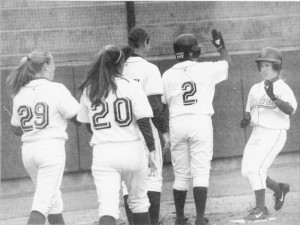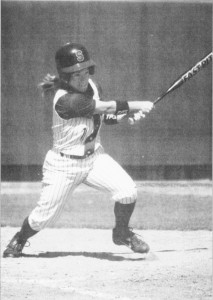Summer 2014 – The morning’s LA Times was scattered across the kitchen table, but Jeanette Shelburne wasn’t interested in any section of the local paper. She sat at the countertop with the laptop open and a cup of warm joe in a Stanford mug just within reach. A feature story awaited her attention: “LeBron James returns home.” It was just another profile her daughter Ramona had written for ESPN, this time in the short span of 36 hours. Still, it needed mom’s final stamp of approval before it headed to her editors in the newsroom.
“My mom is still my best editor,” Ramona said.
Ramona Shelburne, 35, has always been a homebody. She currently lives in Los Angeles, not far from where she grew up. As a sportswriter and on-air analyst for the ESPN Los Angeles news beats, Shelburne has learned the challenges and frustrations of being a female reporter in a man’s world. But it has never acted as a limitation, nor does she complain about it. She still gets the right sources and the coveted interviews because she develops rapport and creates relationships that are genuine.

“It doesn’t matter whether you are a male or female; people respect people who know the game,” Shelburne said.
Growing up, Shelburne was always around or in a game. Whether it was basketball, soccer or softball, she didn’t care. All that mattered was that it was competitive and she was going to win.
“She wanted to be the best. She wanted to get it right. She wanted to do it right away,” her mother said.
But being the best had nothing to do with being a writer.
“She said to me once, ‘Mom, I’m not gonna be a writer like you. I’m gonna do something real.’ So I thought to myself, ‘Okay. That means she’s gonna be a writer.’ She was just trying to be rebellious.”
In 1997, her freshman year at Stanford, Shelburne found herself submitting her first men’s golf tournament recap to The Stanford Daily. The piece, she said, was terrible, but it started her career.
Jeanette was more than excited about her daughter’s newfound hobby. As a professional screenwriter who had worked on several popular children’s television shows, she didn’t expect her daughter to follow her career path.
But writing for The Daily quickly turned into reporting for Sports Illustrated for Women in New York City, which eventually brought her back to Southern California and the Los Angeles Daily News.
Shelburne has always been drawn to California. With two Ivy League colleges looking to recruit her for softball, Ramona chose Stanford over Harvard because of its proximity to her family.
Family matters, and as Jeanette adjusted her chair and put her glasses on to dive into Ramona’s draft, she was about to find out the same was true for LeBron James.
The drive took about 35 minutes. Neither man in the car said a word. Everything LeBron James was feeling on that trip to the airport four years ago – the pain, the angst, the loss, the fear – was written on his face.
Forty-three words – Jeanette wrote down on lined notebook paper. It was the first paragraph of the 3,337-word draft describing James’ decision to return home to Ohio to play basketball for the Cleveland Cavaliers. Where are you going with this, Ramona? Jeanette wondered.
She continued to read, circling Ramona’s lede.
The decision to leave his hometown Cleveland Cavaliers for the Miami Heat had been made that morning.
Jeanette didn’t know or care too much about sports. “I am only interested because she’s involved in it,” she said. This makes her the perfect candidate to read Ramona’s work. “If I can understand it,” she said, “anyone can.”
She did, however, know that James’ announcement was going to create headlines and waves. Akron isn’t Miami. The population is about half the size and the winters are far colder than even the most brisk day in Miami.
But for James, it’s home.
Jeanette jotted down a few more notes on her notepad before closing the laptop: Add more here, elaborate on this and don’t forget a comma there.
Jeanette picked up the phone to call her daughter, ready with comments and annotations to improve her writing and add missing detail.
Ramona talks with her parents every day. It wasn’t a surprise to see their home number pop up on her cellphone at work. As Jeanette voiced her suggestions about the story, Ramona couldn’t help but feel a heaviness come over her.
“Why does this piece matter?” Jeanette said. “How is it different than the rest of the news stories that are going to be written about this?”

How was it going to be different?
She hung up the phone and contemplated. After writing for more than 14 years, she knew how to write a story — that is, where you put the lede, why you need a nut graf and the proper way to format quotes — but something was missing.
“Every character has to change and evolve through the course of a story,” she said. “Every character has a journey.”
Ramona’s journey as a sportswriter revolves around relationships.
“Interpersonal relationships — that’s what being a sportswriter comes down to,” she said. She chats with Kobe Bryant after games about real life, off the record. She laughs with Dwight Howard on the set of SportsNation. She has a rapport.
“She’s really good with people and that’s where that loyalty and heart comes in,” Jeanette said. “She’s aware that these are people.”
With great relationships, Ramona knew it wasn’t a matter of getting the right quote. She already had those. It was about making her piece her own.
Her introspective nature acts as her driving force as a writer, and in this case was exactly what she needed to highlight in her piece.
“Having empathy, emotional intelligence and understanding the people you are interacting with – that’s what I try to bring to my writing,” she said.
What mattered most to James was what mattered most to Ramona – family.
Over her career, Ramona has had many opportunities to further her career, but it wasn’t what was most important in her life. Just like her decision to attend Stanford over Harvard, the choice to reside in Los Angeles was made easy by the people she loves most.
“I had a lot of chances to move but my family is here, and it’s really important for me to stay home. That’s what’s important to me in my life,” she said.
James’ story wasn’t about his career-high 61 points back in March or the signing bonus he would get for renewing his contract with the Miami Heat. His journey as a basketball player was about what mattered most in his life.
“He wanted to play at home. You could just tell he really just felt good about going home. This was what’s in his heart. I felt it,” she said.
She made one final addition to the end of the piece.
But leaving home tends to help a man understand himself, what’s in his heart and what matters in the end.
“My relationship with Northeast Ohio is bigger than basketball,” James wrote in his SI letter. “I didn’t realize that four years ago. I do now.”
It was done.
Two days later, Jeanette sat back down at the kitchen table. She had a freshly-brewed cup of coffee tight in her grasp and her laptop opened, positioned directly in front of her seat. There was no pen, paper or phone within reach. She took a sip of her steaming coffee and sat back in her chair looking at the story on ESPN.com: “This is home for LeBron James,” by Ramona Shelburne. It was just another feature her daughter had published for ESPN, but in actuality, it was so much more. It defined her as a sportswriter, her style of writing, her emotional connections to real people, and what will always be her driving force, her family.
Contact Erin Ashby at eashby ‘at’ stanford.edu.
